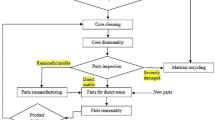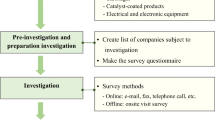Abstract
Remanufacturing can reduce the energy intensity and associated greenhouse gas (GHG) emissions significantly and increase the eco-efficiency of product systems by utilizing recovered end-of-life parts. This paper presents the GHG mitigation potential of technically feasible remanufactured alternators in Indonesian small- and medium-sized enterprizes. Life cycle assessment approach and Weibull ++8 software have been used to calculate environmental and quality parameters. Since existing remanufactured alternators have not been found to meet the technical criterion for customers’ satisfaction, a number of alternative remanufacturing strategies have been explored to identify an option that has not only reduced GHG emissions but also has satisfied reliability, durability and warranty period criterion. Three improvement scenarios involving three different remanufacturing strategies were investigated in this case study, and yielded useful insights in order to come up with a technically feasible remanufacturing strategy for reducing a significant amount of GHG emissions. The improvement scenario III, which maximizes the use of used components, was found to offer technically and environmentally feasible remanufacturing solutions. Overall, this research has found that about 7207 t of CO2 -eq GHG emissions and 111.7 TJ embodied energy consumption could potentially be avoided if 10 % of alternators in Indonesian automobile sector are remanufactured using technically feasible remanufacturing strategy.






Similar content being viewed by others
References
ABB (2011) Indonesia—energy efficiency report. Global energy efficiency 2011. Web https://library.e.abb.com/public/1a65dd16a3c538acc125786400514251/Indonesia.pdf. Accessed 20 June 2012
Anityasari M (2009) An integrated assessment model for reuse strategy technical, social, environmental, and economic aspects. VDM Verlag, Germany
Ardiansyah F (2011) The energy challenge. Inside Indonesia. Web http://www.insideindonesia.org/feature/the-energy-challenge-18071467. Accessed 1 June 2012
Ardiansyah F, Gunningham N, Drahos P (2012) An environmental perspective on energy development in Indonesia. In: Caballero-Anthony M, Chang Y, Putra N (eds) Energy and non-traditional security (NTS) in Asia. Springer, Berlin, pp 89–117
BBB Industries (2014) Premium remanufactured alternators. http://www.bbbind.com/alternators.html. Accessed 30 June 2014
Biswas WK (2014) Carbon footprint and embodied energy assessment of a civil works program in a residential estate of Western Australia. Int J Life Cycle Assess 19:732–744
Biswas WK, Rosano M (2011) A life cycle greenhouse gas assessment of remanufactured refrigeration and air conditioning compressors. Int J Sust Manuf 2(2–3):222–236
Biswas WK, Duong V, Frey P, Islam MN (2011) A comparison of repaired, remanufactured and new compressors used in western australian small- and medium-sized enterprises in terms of global warming. J Remanuf 3(4):1–7
Copper Development Association (2014) Copper recycling and sustainability. http://copperalliance.org.uk/education-and-careers/education-resources/copper-recycling-and-sustainability-1. Accessed 10 Feb 2014
Dewi RG (2010) Indonesia’s progress in waste inventory, 8th workshop on GHG inventories in Asia (WGIA8)—capacity building for measurability, reportability and verifiability. Lao PDR, Vientiane
Dhewanthi L (2007) Addressing financial obstacles of micro small medium enterprises (msmes) for environmental investment in Indonesia. In: Greening the business and making environment a business opportunity. United Nations, ESCAP, Bangkok
Dyker DA, Higginbottom K, Kofoed N, Stolberg C (2006) Analysing FDI in central east Europe through case studies. In: Dyker DA (ed) Closing the EU east west productivity gap, chapter 4. Imperial College Press, London, pp 71–92
Fatimah YA (2015) Remanufacturing as a potential means of attaining sustainable industrial development in Indonesia. Dissertation, Curtin University, Perth
Fatimah YA, Biswas WK (2015) Sustainability assessment of remanufactured computers, 13th global conference on sustainable manufacturing—decoupling growth from resource use, Vietnam, September 16–18
Fatimah YA, Biswas W, Mazhar MI, Islam MN (2013) Sustainable manufacturing for Indonesian Small- and Medium-sized Enterprises (SMEs): the case of remanufactured alternators. J Remanuf 3(6):1–13
Giuntini R, Gauddette K (2003) Remanufacturing: the next great opportunity for boosting US productivity. Business horizons November–December, pp 41–48
Gray C, Charter M (2007) Remanufacturing and product design: designing for the 7th generation. University College for Creative Arts, Farnham
Isites (2016) Building a global energy backbone, Harvard University. http://isites.harvard.edu/fs/docs/icb.topic1046602.files/CaseStudy2_2.pdf. Accessed 8 Feb 2016
Jung D, Seo Y, Chung W, Song H, Jang J (2008) The quality stability improvement for remanufactured alternator. In: Proceedings of the global conference on sustainable product development and life cycle engineering sustainable and manufacturing VI, Busan, South Korea, 29–30 September, pp 147–149
Kerr W, Ryan C (2001) Eco-efficiency gains from remanufacturing: a case study of photocopier remanufacturing at Fuji xerox, Australia. J Cleaner Prod 9(1):75–81
King AM, Burgess SC, Ijomah WL, McMahon CA (2006) Reducing waste: repair, recondition, remanufacture or recycle? J Sustain Dev 14(4):257–267
Krajnc D, Glavic P (2003) Indicators of sustainable production. Clean Technol Environ Policy 5:279–288
Liao Q, Wang X, Ling D, Xiao Z, Huang H (2011) Equipment reliability analysis based on the mean-rank method of two-parameter Weibull distribution. IEEE, Xi’an, China, 17–19 June
Liu SC, Shi PJ, Xu BS, Xing Z, Xie JJ (2005) Benefit analysis and contribution prediction of engine remanufacturing to cycle economy. J Central South Univ Techechnol 12(2):25–29
McKinsey and Company (2009) Environmental and energy sustainability: an approach for India. McKinsey and Company, Mumbai 400 021, India
Ministry of Finance (2009) Low carbon development options for Indonesia: emissions reduction opportunities and policies. Ministry of Finance, Jakarta
Nasr N (2012) Key Legal and business issues in remanufacturing as a key to industrial sustainability. In: Green technology law and business 2012: legistlation, financing, carbon trading and sustainability. Practicing Law Institute, New York
Nyiwul L, Shittu E, Dhanda KK (2015) Prescriptive measures for environmental performance: emission standards, over compliance, and monitoring. Clean Technol Environ Policy 17:1077–1091
PRe Consultants (2013) Simapro 7.3. PRe consultants, The Netherlands
Ramoni MO, Zhang H (2013) End-of-life (EOL) issues and options for electric vehicle batteries. Clean Technol Environ Policy 15:881–891
Reliasoft (2013) Weibull ++. Reliasoft Asia Pte Ltd
Remy International, Inc (2012) Remy International, Inc. - Investor Relations. United States Securities and Exchange Commission, Washington, DC 20549
Romeu JL (2004) Understanding series and parallel systems reliability. Reliability Analysis Center (RAC), Rome, NY
SAE International (2001) Alternator remanufacturing/rebuilding procedures includes passenger car, heavy duty, industrial, agriculture and marine. SAE International Web. http://www.sae.org/. Accessed 20 June 2014
Smith VM, Keoleian GA (2004) The value of remanufactured engines: life-cycle environmental and economic perspectives. J Ind Ecol 8(1–2):193–221
Steinhilper R, Brent AC (2003) Saving product lives in global and local remanufacturing networks: a scientific and commercial work report and an outlook. EcoDesign Conference Proceedings, Tokyo, Japan, pp 297–302
Svenska Kullagerfabriken (2014) Annual report 2014: financial, environmental and social performance. Aktiebolaget SKF, SE-415 50 Gothenburg, Sweden
Tambunan T (2006) SME capacity building Indonesia. Kadin Indonesia-JETRO, Jakarta
Todd JA, Curran MA (1999) Streamlined life-cycle assessment: a final report from the society of environmental toxicology and chemistry (SETAC). 1999. SETAC North America streamlined LCA workgroup. Society of environmental toxicology and chemistry (SETAC) and SETAC foundation for environmental education, Pensacola, FL
US Energy Information Administration (2013) Indonesia. US Energy Information Administration, Washington
US Environmental Protection Agency (2015) Climate change. http://www3.epa.gov/climatechange/science/indicators/ghg/global-ghg-emissions.html
Weibull.Com (2014) Life data analysis (Weibull Analysis). Reliability engineering resources web. http://www.weibull.com/basics/lifedata.htm. Accessed 30 July 2014
Woo JW, Jeong DH, Kim TK, Yoo JY (2008) A study on the method of reliability improvement for remanufacturing alternator and starter. In: Proceedings of the global conference on sustainable product development and life cycle engineering sustainable and manufacturing VI, Busan, South Korea, 29–30 September, pp 147–149
Acknowledgments
This paper is an outcome of the doctoral work and so the authors sincerely appreciate the Indonesian Directorate General of Higher Education (DIKTI) for the financial support granted through doctoral scholarship, and Muhammadiyah University of Magelang for the support and encouragement with regard to this doctoral study.
Author information
Authors and Affiliations
Corresponding author
Rights and permissions
About this article
Cite this article
Fatimah, Y.A., Biswas, W.K. Remanufacturing as a means for achieving low-carbon SMEs in Indonesia. Clean Techn Environ Policy 18, 2363–2379 (2016). https://doi.org/10.1007/s10098-016-1148-5
Received:
Accepted:
Published:
Issue Date:
DOI: https://doi.org/10.1007/s10098-016-1148-5




